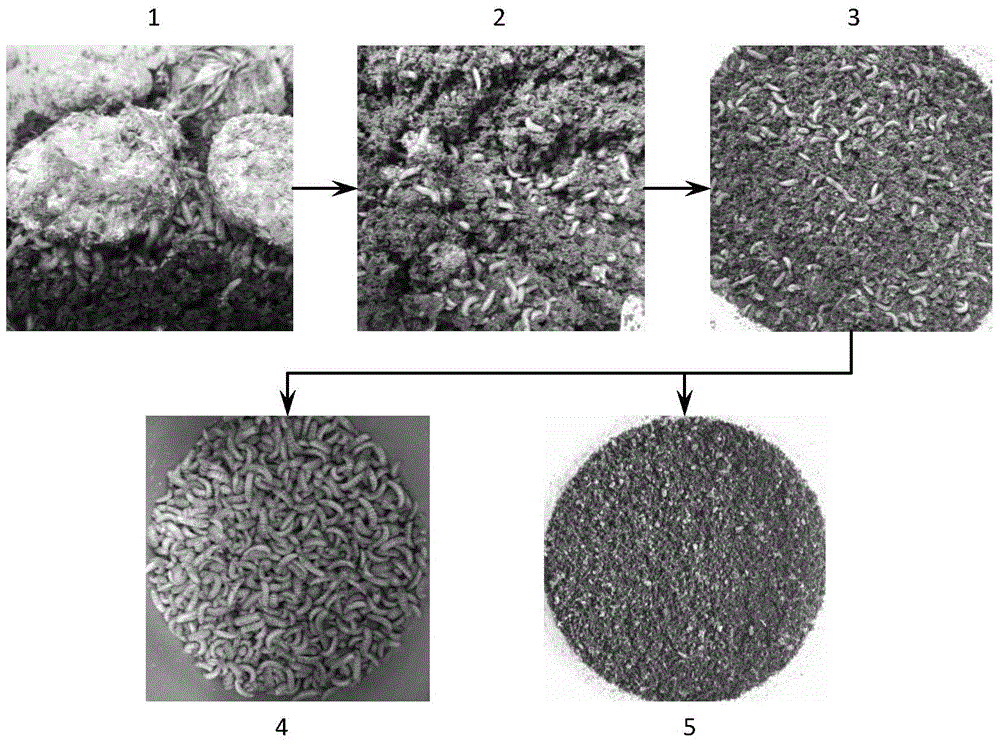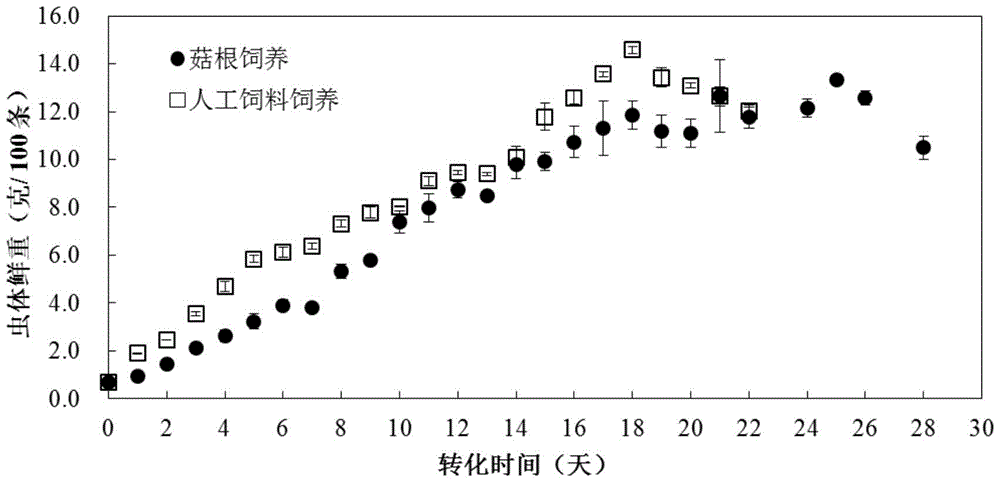Method for converting edible mushroom root wastes through stratiomyiidae larvae
A technology of soldier flies and larvae, which is applied in the field of transforming edible mushroom root waste by using soldier fly larvae to achieve strong immune function, achieve harmlessness, and shorten the transformation time
- Summary
- Abstract
- Description
- Claims
- Application Information
AI Technical Summary
Problems solved by technology
Method used
Image
Examples
Embodiment 1
[0034] A method utilizing soldier fly larvae to transform edible mushroom root waste, comprising the steps of:
[0035] 1) The roots of Flammulina velutipes with a dry weight of 1.0kg are sprayed with water to make them fully soaked, with a water content of 75%; the roots are tiled, and the tile height is 12cm.
[0036] 2) Hatch 0.80 grams of soldier fly eggs (about 3000-4000 eggs, hatching rate greater than 50%) under humid conditions, the air humidity should be greater than 70%, collect 2000 hatched 1-day-old larvae (about 0.42g), Raise in artificial feed for 7 days, spread evenly on the mushroom root surface of step 1), and start transformation; set the artificial feed of the same condition as the control group;
[0037] 3) Keep the room temperature between 20-30°C, and the internal temperature of the mushroom root ≤ 45°C. During the transformation process, spray water to control the water content of the mushroom root to 70-80%. The growth of soldier flies is as follows: f...
Embodiment 2
[0049] Investigating the effects of different inoculation ratios of worms on the conversion rate, material reduction rate and worm weight gain of mushroom root transformation
[0050]In order to investigate the inoculation ratio of mushroom root transformation and optimize the inoculation parameters, Pleurotus eryngii mushroom roots were selected as the transformation object, and different inoculation parameters (60 / 80 / 100 / 120 / 140 / 160g dried mushroom roots) were set: (200 pieces for 6 days age soldier fly larva), regulate the water content of Pleurotus eryngii, and transform, comprising the following steps:
[0051] 1) In a small plastic bucket, add 60, 80, 100, 120, 140 and 160 g of dried Pleurotus eryngii mushroom roots respectively, add distilled water to fully soak the mushroom roots, and adjust the moisture content of each group of mushroom roots to 75%. Mix well for 1 hour. Mushroom roots are spread on the bottom of the barrel with an average height of 12cm.
[0052] 2...
Embodiment 3
[0059] Using chicken manure, kitchen leftovers, and bran to compound with edible mushroom roots respectively, to promote the transformation of soldier flies and shorten the transformation time, including the following steps:
[0060] 1) Measure the moisture content of auxiliary materials (fresh chicken manure, kitchen residues, bran) and edible mushroom roots, calculate the respective solid content according to the moisture content, and then use the dry weight ratio: a) mushroom root 100%, b) Mushroom roots 80%+auxiliary materials 20%, c) mushroom roots 60%+auxiliary materials 40%, d) mushroom roots 40%+auxiliary materials 60%, e) auxiliary materials 100% in five levels, chicken manure, kitchen leftovers, The bran and edible mushroom roots are compounded to form a compound material, and the compound material is sprayed with water to keep the material moist, and the water content is measured respectively, and the range is between 65% and 75%; in order to investigate the influenc...
PUM
 Login to View More
Login to View More Abstract
Description
Claims
Application Information
 Login to View More
Login to View More - R&D
- Intellectual Property
- Life Sciences
- Materials
- Tech Scout
- Unparalleled Data Quality
- Higher Quality Content
- 60% Fewer Hallucinations
Browse by: Latest US Patents, China's latest patents, Technical Efficacy Thesaurus, Application Domain, Technology Topic, Popular Technical Reports.
© 2025 PatSnap. All rights reserved.Legal|Privacy policy|Modern Slavery Act Transparency Statement|Sitemap|About US| Contact US: help@patsnap.com



